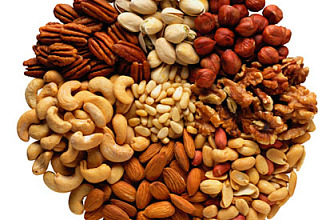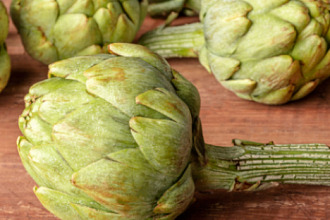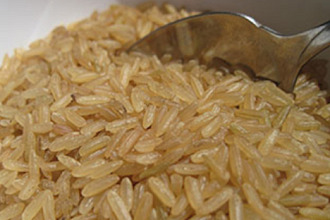As a kid, nuts were a luxury in our home, and we only had them on special occasions such as birthdays and Christmas because nuts were expensive in the 1950s. In the last twenty years, nutritional experts cautioned us to avoid nuts or use them sparingly because they are high in calories and fat. Even today, the average American consumes only three quarters of an ounce per day, and only a third of us eat any type of nuts at all on a given day. Europeans consume about 1.1 ounces per day and an even higher consumption in Mediterranean countries.1
Nuts were part of the Edenic diet. Records of ancient civilizations describe the first trail mix of ground almonds and pistachios with chopped dates, sesame oil, and bread crumbs. Almonds were discovered in the famous Tutankhamen’s tomb and in pyramids of other pharaohs of Egypt. In the last two decades food science has focused on the health benefits of nuts for the prevention of cardio disease—and more recently, on protecting bones and combating diabetes. If you want a simple way to live longer, eating a handful of nuts a day may be the right answer. In a recent study in the New England Journal of Medicine, researchers followed 119,000 men and women for three decades. The study showed that those who ate walnuts, almonds, and other nuts seven or more times a week were 20 percent less likely to die from any cause during these 30 years than those who didn’t eat nuts.
Overall, nuts are low in carbohydrates and rich in “good” fats (mono and polyunsaturated fatty acids), fiber, vitamin E, and protein.2
The majority of foods we describe as nuts are tree nuts which are seeds or dried fruits from trees. Tree nuts include walnut, almond, cashew, hazelnut (also called filbert), Brazil nut, macadamia, pecan, pistachio, chestnut (starchier and contains different micronutrients), and pine nut. The one exception in the world of nuts is the peanut, which is actually a legume that grows in the ground like peas and beans. The peanut commands two-thirds of U.S. nut market.3
Cracking Open the Health Benefits of Nuts
According to Dr. Jeffery Blumberg, director of Tufts University HNRCA Antioxidants Research Laboratory, nuts are excellent sources of vitamin E and magnesium. For example, over 90 percent of us don’t get enough dietary vitamin E which is needed for protection against oxidative damage to our cells and assists in immune functions. If you analyze the average American diet, it is difficult to get enough of this vitamin without going overboard on fats. However, consumption of almonds and sunflower seeds solves both the calorie intake and the vitamin problem. When it comes to magnesium, over 80 percent of Americans lack this important element. Eating nuts high in magnesium (Brazil nuts, almonds, and cashews) can decrease your risk for heart disease, stroke, diabetes, hypertension, and osteoporosis.4
To give us an idea of the real value of nuts in relation to chronic diseases and overall health, I have taken the liberty to emphasize just one nut—the walnut.
Walnut’s Surprising Benefits
Walnut growers often market the walnut as “a whole food with whole-body benefits” or an “essential food for health.” The FDA enhanced these logos, stating in 2004 that “supportive but not conclusive research shows that eating 1.5 ounces of walnuts per day, as part of a low saturated fat and low cholesterol diet, and not resulting in increased caloric intake may reduce the risk of coronary heart disease.”5
Further evidence of the health benefits of walnuts was recently shown in a heart-health test by Loma Linda University researchers. They recruited 25 adults with normal to mildly high cholesterol and tested them with three different diets for four weeks. These control diets included a diet with no nuts or fish, a diet of moderate amount of walnuts, and a regimen of two servings of salmon per week. The conclusions as reported in the American Journal of Clinical Nutrition showed the consumption of the walnut diet reduced both the total and LDL (bad) cholesterol levels. In addition, the ratio of total cholesterol to HDL (‘good’) was found to be the lowest in the walnut group.6
Other studies have shown walnut’s possible health benefits in both diabetes and cancer. In the now famous Nurses Health Study, women who ate a minimum of five ounces of nuts per week were least likely to develop type 2 diabetes during the study’s 16-year follow-up.
Researchers at Marshall University School of Medicine found that mice had a significant lower risk of cancer when they were fed the human equivalent of two ounces of walnuts daily. These particular mice were bred to develop breast cancer but when fed a walnut diet their rate of malignancy was cut in half. In a presentation at the American Association for Cancer Research’s annual meeting, the lead researcher stated, “Walnuts contain multiple ingredients that, individually, have been shown to slow cancer growth, including omega-3 fatty acids, antioxidants, and phytosterols.”7
As stewards of our health and lifestyle, let’s add a handful of nuts to our daily diet and certainly enjoy them as part of our heart-healthy snacks.
References:
1 “Nuts for You,” Tufts University Health & Nutrition Letter, Special Supplement, May 2012, p. 1.
2 “Daily Handful of Nuts Linked to Lower Mortality Risk,” Tufts University Health & Nutrition Letter, March 2014.
3 “Nuts for You,” Tufts University Health & Nutrition Letter, Special Supplement, May 2012, p. 1.
4 Ibid.
5 “Walnuts May Benefit Heart & Brain, Even Fight Cancer,” Tufts University Health & Nutrition Letter, July 2009, p.6.
6 Ibid.
7 Ibid.


























